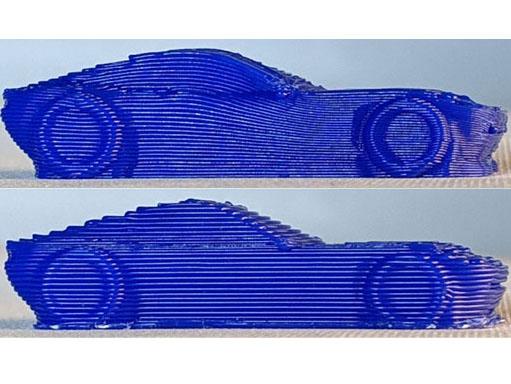Make more with your 3D printers: from smooth surfaces to complex patterns

The top car was printed using the CurviSlicer program, while the one on the bottom was printed using a lower quality program. Credit: ©Inria
Scientists from the MFX team led by Sylvain Lefebvre, research director at Inria, will present innovative and open-access algorithms that enable new possibilities on your regular fused filament printer. From 3D printing nearly-perfect round shapes, to producing flexible objects with complex elastic behaviors, or producing oriented grip patterns and multi-materials structures: their presentations will cover most of the fabrication process!
The MFX team, together with colleagues from other Inria teams (Pixel, Maverick, and Imagine) is dedicated to empowering owners of even the most basic machine to come up with creative and state-of-the-art productions.
30 July 2019 – 11:51 am – Los Angeles Convention Centre, room 153
« High performance rendering » session
Thibault Tricard and Semyon Efremov will unveil the new generation of irregular pattern generation software, paving the way for an easier production of composite materials with different properties in different directions.
Read more : https:/
[Procedural Phasor Noise – https:/
31 July 2019 – 11:29am – Los Angeles Convention Centre, room 150/151
« Fabrication » session
Jimmy Etienne will present an innovative software that facilitates the production of round shaped objects with a regular 3D printer.
Read more : https:/
[CurviSlicer: Slightly curved slicing for 3-axis printers – https:/
31 July 2019 – 11:51am – Los Angeles Convention Centre, room 150/151
« Fabrication » session
Jonàs Martinez will tell you everything about the production of meta-material made of repetitions of with star-shaped units, thus showing surprising properties that you definitely can't find in any natural material.
Read more : https:/
[Star-Shaped Metrics for Mechanical Metamaterial Design – https:/
The MFX team, located in Nancy, France, is common to Inria and the Loria. Its members focus on challenges related to shape complexity in the context of Computer Graphics and Additive Manufacturing. They consider the entire chain from modeling, visualization to interaction and part geometry processing before fabrication. They are at the origin of the IceSL open-access software.
Sylvain Lefebvre and his team will be available to answer your questions and discuss what new avenues their algorithms open up at any time, during the conference or after.
About Inria: Inria, the French national research institute for the digital sciences, promotes scientific excellence and technology transfer to maximise its impact.
It employs 2,400 people. Its 200 agile project teams, generally with academic partners, involve more than 3,000 scientists in meeting the challenges of computer science and mathematics, often at the interface of other disciplines. Inria works with many companies and has assisted in the creation of over 160 startups. It strives to meet the challenges of the digital transformation of science, society and the economy.
The Inria Nancy – Grand Est research centre was founded in 1986 to contribute to the economic revival of the region. It grew steadily from 7 project-teams and 50 people in 1990, to 21 project-teams and 450 people today, across three sites: Nancy, Strasbourg and Saarbru?cken. The Inria Nancy – Grand Est research centre develops most of its scientific activities in partnership with the French National Centre for Scientific Research (CNRS), the University of Lorraine and the University of Strasbourg. It also maintains close ties with other research institutes and universities from the wider region, mainly in Saarbru?cken and Luxembourg. Its research is structured around five main broad topics that you can find online: https:/
###
MEDIA CONTACTS
Laurence Goussu – +33 (0)6 81 44 17 33
laurence.goussu@inria.fr
Sylvain Lefebvre – @sylefeb
sylvain.lefebvre@inria.fr
Véronique Poirel – +33 (0)6 84 82 23 15
veronique.poirel@inria.fr
Media Contact
More Information:
https://www.inria.fr/en/centre/nancy/news/smoother-3d-printsAll latest news from the category: Trade Fair News
Newest articles

Innovative vortex beam technology
…unleashes ultra-secure, high-capacity data transmission. Scientists have developed a breakthrough optical technology that could dramatically enhance the capacity and security of data transmission (Fig. 1). By utilizing a new type…

Tiny dancers: Scientists synchronise bacterial motion
Researchers at TU Delft have discovered that E. coli bacteria can synchronise their movements, creating order in seemingly random biological systems. By trapping individual bacteria in micro-engineered circular cavities and…

Primary investigation on ram-rotor detonation engine
Detonation is a supersonic combustion wave, characterized by a shock wave driven by the energy release from closely coupled chemical reactions. It is a typical form of pressure gain combustion,…



